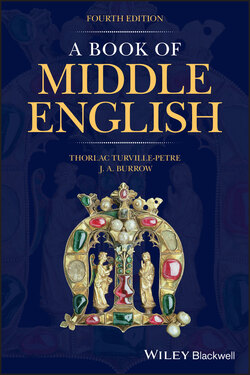Читать книгу A Book of Middle English - J. A. Burrow - Страница 15
1.2.1 Regional Dialects
ОглавлениеThe main source of diversity in written Middle English is regional and local variation. Spoken English has always been diversified in this way and still is today; but literary texts outside the Middle English period rarely exhibit any regional forms other than those represented in the written standards observed by authors, scribes or printers. By contrast, authors in the twelfth, thirteenth and fourteenth centuries generally wrote the English that they spoke – whether in London, Hereford, Peterborough, or York – and the scribes who copied their work either preserved that language or else more or less consistently substituted their own, equally local, forms.
There are several different ways of classifying the many regional varieties of Middle English. The simplest is to distinguish, as John Trevisa did in the fourteenth century, between ‘Southeron, Northeron, and Myddel speche’. Modern scholars commonly make further distinctions, at least for the Southern and Midland areas, which are more fully represented in surviving texts than the Northern. Thus, in our own map (p. 7), we distinguish South‐Eastern from South‐Western, and West Midland from East Midland. Further refinements are of course possible; but even these bear only a rough‐and‐ready relation to realities. To describe a regional dialect is to specify certain features which are held to be characteristic of its vocabulary, idiom, spelling, grammatical forms, sounds, etc. But if you take such features and map them individually according to their occurrence in localizable texts, as has been done for many in the Linguistic Atlas of Late Mediaeval English (see Bibliography, 9.2, and map p. 16 here), two awkward facts emerge. First, an individual dialect feature – say, a locally characteristic word – will not normally be separated off from its neighbouring alternatives by a clear boundary. Second, such boundaries as can be drawn, albeit roughly, for individual features – the so‐called ‘isoglosses’ – will not commonly coincide or bundle together with one another in such a way as to define a single firm and satisfactory dialect boundary. Rather, what one finds is a ‘complex of overlapping distributions’ (Linguistic Atlas I 4).
Something of the range of dialect variation in Middle English may be gathered from text 18a, the Reeve’s Tale. Here Chaucer, himself a Londoner, imitates the speech of two students from ‘fer in the north’ – probably Northumberland, and therefore well north of the northernmost of our texts (no. 15). He notices three main types of feature:
Phonological: especially the Northern preservation of Old English (and Scandinavian) /a:/ in words where London English had an ‘open o’, /ɔ:/ (see 2.2.1 below). Thus: bathe, twa, wha, when Chaucer normally has bothe, two, who.
Inflexional: especially the ‐(e)s ending for the third person present indicative of verbs (see 4.5.2 below). Thus: he fyndes, he brynges. This Northern and North Midland form later spread south and superseded Southern ‐eth, which was Chaucer’s usual form. Hence it is the students’ form, not Chaucer’s, which will in this case appear ‘normal’ to the modern reader.
Lexical: words and meanings alien to London English. Thus: the words heythen, ‘hence’, and ille, ‘bad’; and hope in the sense ‘expect’. Many of these are of Scandinavian origin (see 3.2 below).The dialect areas of Middle English cannot be at all precisely mapped, as one can map a county. It remains possible, of course, to describe this or that feature as broadly characteristic of this or that area; and later sections of this introduction will touch on some regional variations in inflexions and vocabulary. But the introduction will mostly be concerned with outlining the general features of Middle English, leaving peculiarities of individual texts to be briefly treated in their respective headnotes.
The dialects of Middle English. The mappings of the texts are approximate. They represent the dialects of the texts as printed here from scribal copies, which may differ from the author’s own regional form of English. For further details see the individual headnotes, and for comments on ‘dialect boundaries’ see 1.2.1.
1 The Peterborough Chronicle
2 The Owl and the Nightingale
3 Laʒamon’s Brut
4 Ancrene Wisse
5 Sir Orfeo
6 The Cloud of Unknowing
7 Langland: Piers Plowman
8 Patience
9 Sir Gawain and the Green Knight
10 Pearl
11 St Erkenwald
12 Trevisa: Dialogue between a Lord and a Clerk
13 Gower: Confessio Amantis
14 Lyrics
15 The York Play of the Crucifixion
16 Chaucer: The Parliament of Fowls
17 Chaucer: Troilus and Criseyde
18 Chaucer: The Canterbury Tales
19 Julian of Norwich: Revelations of Divine Love
